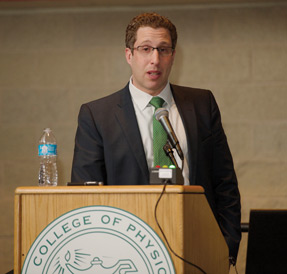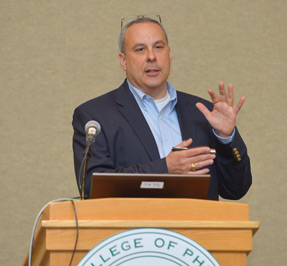Disclosing medical errors the right way
After a medical error, patients want an explicit statement that an error occurred, what happened, and the implications for their health. They want an outright apology, not a statement of regret. Work from global organizations is refining the right way to disclose errors.
Making a sincere apology for a medical error is no easy task, according to Wendy Levinson, MD, FACP, an expert on medical error disclosure.
“I've run workshops with fake patients where the physicians are sweating as they practice this,” said Dr. Levinson, a professor in the department of medicine at the University of Toronto Institute of Health Policy, Management and Evaluation, during a session at Internal Medicine 2014 titled “Disclosing Medical Errors to Patients: Considering Where, When, and How.”
In an error disclosure, patients want to hear an explicit statement that an error occurred, what happened and the implications for their health, why it happened, and how recurrences will be prevented in the future for themselves and other patients, she said.
“And they want an apology. Not a statement of regret like, ‘I'm sorry this happened to you,’ but a statement such as ‘I'm sorry I caused you harm,’” Dr. Levinson said.
Several groups around the world have studied the optimal way to disclose errors, she added. This work, from organizations such as the U.S. National Quality Forum, the Canadian Patient Safety Institute, and the U.K.'s National Patient Safety Agency, tends to have the following guidelines in common:
- Begin by stating there has been an error;
- Describe the course of events, using nontechnical language;
- State the nature of the mistake, consequences, and corrective action;
- Express personal regret and apologize;
- Elicit questions or concerns and address them; and
- Plan the next step and next contact with the patient.
“This is harder than it sounds,” Dr. Levinson said. “I encourage you to do some role playing around error disclosure.”
Errors by others
One tricky issue is whether and how to disclose errors made by other clinicians. Ideally, your institution should offer guidance in how to handle this situation, and you should feel comfortable approaching your colleagues to discuss situations that arise.
The disclosure strategy for errors by a colleague likely will depend on the clinical situation, such as whether it involved a physician with whom you were co-managing, or a trainee, or a clinician who didn't have direct contact with the patient.
In the case of co-managing physicians, both should participate in the disclosure regardless of who made the error. In the case of a trainee error, the attending physician and the trainee both should be involved, Dr. Levinson said.
Attendings also should handle disclosure of errors made by a clinician who didn't have direct contact with the patient, although the clinician who made the error should be invited to join if desired, she said.
If the error occurred at another institution or is unrelated to current care, the disclosure should be handled by the medical director at the institution currently caring for the patient, after consultation with the clinician who made the error and/or with the outside institution, she said.
Follow words with actions
It's important to remember, too, that the actions following an apology are as important as the words used in the apology, said co-speaker Thomas Gallagher, MD, FACP, professor of medicine and of bioethics and humanities at the University of Washington School of Medicine in Seattle.
“We've often been too focused on the words we say to patients, but in some respects what's more important are the broader set of actions that follow,” Dr. Gallagher said.
Those actions can include institutional changes. Knowing that those are in the works can be a great comfort to patients, who often want to believe that their experience might lead to a positive change for others, he said.
Institutions have begun to embrace the idea that errors are their responsibility as well as the responsibility of individual clinicians, Dr. Gallagher said. “Communicating with patients after an unanticipated outcome is now seen as a broader part of how we think about high-quality health care; it isn't just about risk management,” he said.
To make their disclosures high quality, institutions should be candid and transparent about unanticipated outcomes, conduct a rapid investigation, offer a full explanation, and apologize as appropriate, Dr. Gallagher said.
Furthermore, where appropriate, the institution should seek to provide for the patient's and family's financial needs resulting from the error, hopefully without having to resort to litigation. And the institution should build systematic patient safety analysis and improvement into its risk management plan, he said.
“Currently, ours is often a system of accountability that doesn't adequately service the patient's need for information, for our accepting responsibility, for timely compensation [when appropriate], and for a sense that we've learned from the mistake,” said Dr. Gallagher. “We need to demonstrate to the patient and the public that learning is happening; in many ways, this is the most important thing we miss.”
Legal concerns: Reporting
The top barrier to improving the culture around medical error disclosure is clinician fear, said Dr. Gallagher. “They are anxious about an unpredictable, punitive response from their institution, regulators, and malpractice insurers. This hampers efforts to learn [from mistakes] and to prevent recurrence.”
Physicians may have more peace of mind if they educate themselves about the regulatory and legal consequences of disclosure, said ACP Member Allen Kachalia, MD, JD, associate professor of medicine at Harvard Medical School and associate chief quality officer at Brigham and Women's Hospital in Boston.
A big concern is often the National Practitioner Data Bank (NPDB), which stores information on medical malpractice payments made for the benefit of a health care practitioner as the result of a written claim or judgment. Institutions are responsible for reporting claims to the NPDB.
Whether an event gets reported to the NPDB, however, can depend in part on the type of communication and resolution program that an institution employs. If it uses a “reimbursement model,” the patient often doesn't release his or her claim to sue when something goes wrong.
“The institution will tell the patient what happened and make an offer of compensation, and because the reimbursement is not done in satisfaction of a legal claim, it may not trigger provider reporting requirements,” Dr. Kachalia said.
If an institution uses an “early-offer-and-settlement model,” the patient generally waives his or her right to file suit. Whether this leads to clinician reporting depends on how the claim is settled. If the claim is settled on behalf of the institution, the clinician may not need to be reported to the NPDB. But if the claim is settled on the clinician's behalf, the physician will be reported to the data bank, Dr. Kachalia said.
“The rules are complex around all this and it helps to know whether your institution employs a reimbursement model or an early-offer-and-settlement model,” Dr. Kachalia said.
Some payers and liability companies also want to know about errors as soon as they occur, as do certain credentialing committees and licensing boards. For these, physicians should be aware of the requirements, he added.
Ripple effects
While there is general agreement in the medical community that there is an ethical obligation to disclose errors and that a culture of transparency helps improve patient safety, there is also concern that disclosure will lead to more claims and lawsuits, Dr. Kachalia said. Limited published data exist on whether disclosure has a snowball effect, he said.
“Some argue that when you tell a patient you've made a mistake, you might be handing over a blank check. Even if you make an offer of compensation, the patient might be unhappy with that offer and still want to sue for more. However, others argue that if you [disclose] sincerely and honestly, patients may be less likely to sue you,” he said.
A disclosure program at the University of Michigan, implemented in 2001, found that apologizing and offering compensation reduced patient claims. Comparing the before/after disclosure period up until 2007, the university saw claims drop by 36%, Dr. Kachalia said.
“Now this doesn't prove that disclosing and making offers will lower your liability experience, but it shows that one institution did this and their claims experience didn't go through the roof; in fact, it got much better,” he said.
Physicians also sometimes worry that they will have more liability insurance costs with greater disclosure. However, this isn't necessarily the case.
“Liability insurance costs are becoming less of a concern for many physicians today. They are still there for many of us, but as more and more of us are actually being employed, our employers are covering our liability insurance costs,” Dr. Kachalia said.
Even if a physician pays his or her own liability premiums, ratings tend to be scored by how much a specialty pays; they are not often experience rated, he said. “So even if you have a claim against you as a result of disclosing an error, it may not raise your premiums,” Dr. Kachalia said.
State laws
Some states have passed laws to try to help facilitate disclosure. One, the so-called “I'm sorry” law, protects statements of apology or regret made at the time of an event against a claim in court, Dr. Kachalia said.
The specifics of “I'm sorry” laws vary by state, with some protecting only expressions of sympathy and others protecting admissions of fault. In some cases, if a clinician makes an inconsistent statement about an error event later, the initial apology can be admissible in court, he said.
Other states have implemented so-called “cooling-off periods,” which means a patient must give a clinician some notice about his or her intention to sue before actually doing so. In Massachusetts, the cooling-off period is 6 months. “The idea is in that in those 6 months, the parties have time to resolve the claim, to prevent it from becoming a lawsuit,” Dr. Kachalia said.
Meanwhile, Oregon passed a law last year designed to improve mediation and encourage transparency. If a clinician or a patient wants help or fears negligence has occurred in a claim, she or he can file with the state's patient safety commission. The commission will bring the parties together, help them find a mediator, and help resolve the claim so it doesn't have to turn into a lawsuit, he said.
What's more, since settlements that are reached through this process don't result from a written claim, they are not reported to the NPDB.
“So what Oregon is trying to do is to encourage people to openly talk about claims, provide a protected environment for doing this, and avoid reporting requirements all at the same time,” Dr. Kachalia said.
State-level reporting requirements also vary. In Massachusetts, any serious reportable event (whether or not it becomes a claim) needs to be reported to the state department of public health. In Michigan, if a claim is settled on behalf of an institution but that clinician was named in it at some point, the clinician will still be reported to the state licensing board.
Given the wide variation in state laws and regulations, Dr. Kachalia said, “It behooves you to know what kind of protection your own state provides” and what the reporting requirements are.




